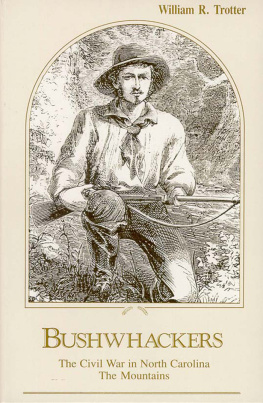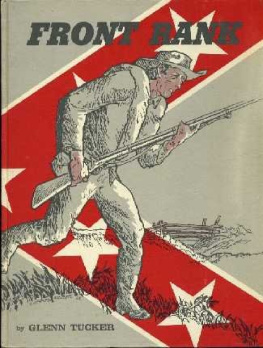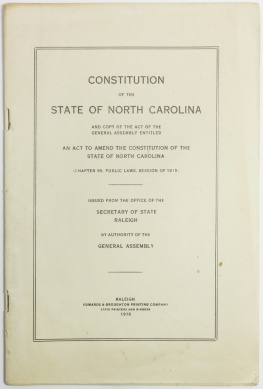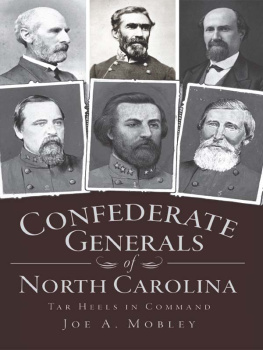
BUSHWHACKERS!
THE CIVIL WAR IN NORTH CAROLINA (VOLUME II: THE MOUNTAINS)
William R. Trotter
DEDICATION
To Craig Gaskell, with love and gratitude.

Copyright 1988 by John F. Blair, Publisher
All rights reserved
Printed in the United States of America
This book is printed on acid-free paper.
Library of Congress Cataloging-in-Publication Data
Trotter, William R.
Bushwhackers : the mountains / William R. Trotter.
p. cm. (The Civil War in North Carolina ; v. 2)
Includes bibliographical references and index.
ISBN 0-89587-087-8 (pbk.)
I. North CarolinaHistoryCivil War, 18611865Underground movements.
2. United StatesHistoryCivil War, 18611865Underground movements.
3. GuerrillasNorth CarolinaHistory19th century.
I. Title. II. Series: Trotter, William R. Civil War in North Carolina ; v. 2.
E470.T79 1991
973.7'4756dc20
90-28760
TABLE OF CONTENTS
In the mountain war the question of allegiance was not easily resolved in the safety of homes surrounded by sympathetic neighbors, secure from far away battlefields. An allegiance was worn as a target over the heart, amid armed enemies, and loyalty could attract both dangerous friends and mortal enemies.
Philip Shaw Paludin: Victims -- A True Story of the Civil War
Although the mountains of North Carolina would have furnished an epic backdrop for a great military campaign, let the reader be aware at once that there were no large battles fought in these mountains during the Civil War not even a single engagement on the scale of Kings Mountain during the Revolution. And yet there was no region in the state which endured more violence over a comparable period of time. Acre for acre, there was probably more gunfighting and gratuitous cold-blooded murder in Appalachian North Carolina during the Civil War than there was in any comparable chunk of the Wild West during any four-year period you care to name.
That claim may seem extreme. But although this book cannot precisely document all of the violence that took place, it does suggest what happened in a tip-of-the-iceberg manner. A great deal of the fratricidal raiding and bushwhacking occurred between small bands of men who operated under no regular military command (or did so only sporadically), and hence there were no official reports filed on most of the violence. Of those who might have been inclined to preserve their experiences for posterity, few were literate enough to write a simple letter, never mind a detailed memoir. Many anecdotes existed for years only in the form of oral tales, passed along within the family, until some local historian happened to write them down, 30 or 50 years after the fact. But based on the few contemporary accounts that do contain any detail, it seems safe to say that for every ambush and shoot-out that did get chronicled, there were probably ten more that did not.
Albert D. Richardson, a correspondent for the New York Tribune who escaped from the Salisbury prison camp and eventually made his way to Federal lines in Tennessee, stayed with dozens of Unionist sympathizers in the North Carolina mountains, and he discovered an incidence of everyday violence that stunned him:
During our whole journey we entered only one house inhabited by white Unionists, which had never been plundered by the Home Guard or Rebel guerrillas. Almost every loyal family had given to the Cause some of its nearest and dearest. We were told so frequently My father was killed in those woods or, The guerrillas shot my brother in that ravine, that, finally, these tragedies made little impression on us.
What existed in the western counties, from about mid-1862 until the wars end (and after, in some places), was a sullen, smoldering atmosphere of deprivation and anxiety, of the constant possibility of violence -- a pervasive condition somewhere between low-level guerrilla warfare and epidemic banditry. The absence of large armies and epic battles did not mean that the war could be held at arms length, or that the inhabitants of the mountain counties could feel themselves protected from wars direct effects, if not from the inevitable grief that came from losing a loved one on a distant battlefield. The war was, on the contrary, all around them. It was characterized by a latent, lurking, sense of menace, combined with economic hardship and periodic outbursts of what can only be described as fratricidal madness.
The entire subject of guerrilla warfare in the Southern Appalachians is one that Civil War historians, on the whole, have been loathe to dirty their hands with. It is not, of course, as colorful as the great campaigns of Virginia or western Tennessee. Although there was plenty of drama in the partisan strife of that era, it was also squalid, brutal, and confusing as confusing to research and write about, in many cases, as it was to experience. But as Karl von Clausewitz pointed out, confusion is endemic to warfare, and extreme brutality is endemic to guerrilla warfare particularly when social, economic, and environmental factors dictate that the fighting is to be largely a matter of neighbor against neighbor. One of my tasks, perhaps the hardest one indeed, has been to minimize that confusion without softening the ambiguities.
Researching this subject was not easy. Only three books have covered aspects of the mountain war in North Carolina. Heading that short list is Philip Shaw Paludins Victims -- A True Story of the Civil War, a poetic, evocative, and meticulously researched account of the Shelton Laurel massacre. I have relied on that classic work for my own treatment of that tragic incident, as any historian who writes about it must. The other two books are Vernon H. Crows magnificently researched but occasionally confusing account of Thomass Legion, Storm in the Mountains, and Ida van Noppens excellent but long out-of-print work, Stonemans Last Raid.
For the rest of the story, the process has been that of assembling a mosaic fragmentary references in obscure county histories, family chronicles, newspaper files, and, of course, that gigantic and formidably confusing repository of Civil War data, the Official Records. If little has been uncovered in the preparation of this book that was totally unknown before, at least much of the information has been assembled into a coherent narrative that was scattered and buried in obscurity until now. By putting it all between two covers, I hope I have made a worthwhile contribution to the history of those times.
The events that happened in the mountain counties of North Carolina, and their contiguous neighbors in eastern Tennessee, furnish a microcosmic view of the Civil Wars effects. The fighting, the suffering, and the dying all took place on an individual scale, and there is a recognizably human profile to the drama. You can tell this much from the way the Civil War period remains alive in the generational memories and oral traditions of the mountain region. This certainly includes, but goes far beyond, the still-vivid demarcations between Republican and Democratic voting patterns in certain counties. For mountain families whose roots go back that far, the collective memories do not stop with the stories of those who fell at Gettysburg or suffered at the hands of Shermans invaders. When they speak of the Civil War, they also speak of the dark night on a backwoods lane when great-great-grandfather was cut down by bushwhackers, or of that raw frontier morning when great-great-grandmother stood on the front porch of her cabin and watched a patrol of Thomass Legion full-blooded Cherokee warriors hot with youth and heritage ride whooping through a patch of morning sunlight with fresh Unionist scalps dangling from their saddle horns.
Next page







